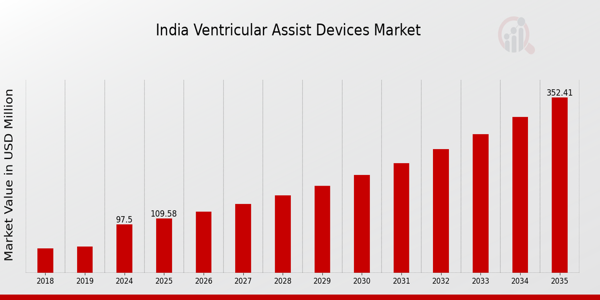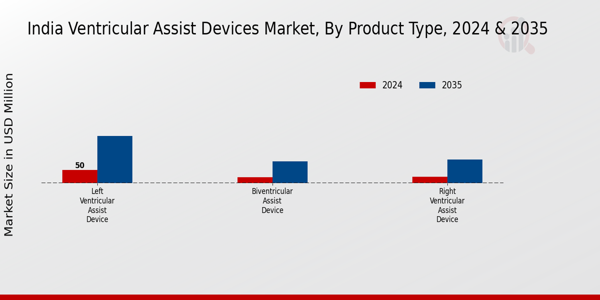India Ventricular Assist Devices Market Overview
As per MRFR analysis, the India Ventricular Assist Devices Market Size was estimated at 90 (USD Million) in 2023. The India Ventricular Assist Devices Market Industry is expected to grow from 97.5(USD Million) in 2024 to 352.4 (USD Million) by 2035. The India Ventricular Assist Devices Market CAGR (growth rate) is expected to be around 12.391% during the forecast period (2025 - 2035)
Key India Ventricular Assist Devices Market Trends Highlighted
The India Ventricular Assist Devices Market is experiencing significant growth, primarily driven by a rise in heart diseases and an increasing aging population. The urban shift in lifestyle factors, such as poor dietary habits and sedentary behavior, has led to a surge in cardiovascular conditions, emphasizing the need for advanced heart treatment options like ventricular assist devices (VADs). Furthermore, the government of India is actively promoting healthcare infrastructure improvements to better manage cardiac diseases, creating a favorable environment for the adoption of VAD technologies.
Opportunities to be explored in this market include the development of new technologies and the introduction of more affordable devices.As healthcare expenditures rise and patient awareness grows, there is potential for innovative solutions that cater to the specific needs of patients in India. Local manufacturing and collaborations between domestic and international firms can also enhance the supply and accessibility of VADs, ensuring they reach a broader patient population. Trends in recent times indicate a shift towards minimally invasive surgical techniques and advancements in device design, which improve the usability and comfort of VADs.
Moreover, as telemedicine gains traction in India, remote monitoring of patients with assist devices is becoming more common, ensuring better management of their health conditions.Awareness programs and training for healthcare professionals further support the growth of this market, indicating a healthcare ecosystem that is becoming increasingly responsive to the needs of those with severe heart diseases. Overall, the synergy between technological advancements and supportive government policies is poised to redefine the landscape of the India Ventricular Assist Devices Market.

Source: Primary Research, Secondary Research, Market Research Future Database, and Analyst Review
India Ventricular Assist Devices Market Drivers
Rising Incidence of Heart Failure
One major factor propelling the India Ventricular Assist Devices Market is the rising prevalence of heart failure. Over 26 million Indians are at risk of heart failure, with 1 in 5 persons in the country at risk, according to the Indian Heart Association. This concerning figure highlights the necessity of cutting-edge therapeutic alternatives, such as ventricular assist devices.
Because of changing lifestyles and an ageing population, institutions such as the All-India Institute of Medical Sciences (AIIMS) have observed an increase in cardiac illnesses, particularly in urban populations. The market is anticipated to develop considerably due to the rising demand for cutting-edge treatments, particularly those that can offer mechanical circulatory support.
Advancements in Medical Technology
Technological advancements in medical devices are propelling the growth of the India Ventricular Assist Devices Market Industry. With enhanced capabilities such as miniaturization, increased efficiency, and better biocompatibility, new iterations of ventricular assist devices are making it easier for healthcare professionals to adopt these life-saving technologies.
Organizations like the Indian Medical Association have reported significant improvements in device design and functionality over recent years.The growing emphasis on Research and Development (R&D) by both domestic and international manufacturers has led to innovations that cater specifically to the Indian demographic, effectively addressing local market needs and expectations.
Government Initiatives to Improve Heart Health
Government initiatives aimed at addressing cardiac health issues are contributing to market growth in the India Ventricular Assist Devices Market Industry. The Indian government has implemented several health programs focused on reducing cardiovascular disease prevalence. For instance, the National Program for Prevention and Control of Cancer, Diabetes, Cardiovascular Diseases and Stroke (NPCDCS) emphasizes early detection and effective management of heart diseases.
Enhancements in healthcare infrastructure, along with increased funding for cardiology units, directly influence the demand for advanced treatments such as ventricular assist devices. These initiatives facilitate better access to innovative technologies, ultimately expanding the market.
India Ventricular Assist Devices Market Segment Insights
Ventricular Assist Devices Market Product Type Insights
The 'India Ventricular Assist Devices Market' showcases a comprehensive structure within its Product Type segmentation, primarily consisting of Left Ventricular Assist Devices (LVADs), Right Ventricular Assist Devices (RVADs), and Biventricular Assist Devices (BiVADs). The Left Ventricular Assist Device segment notably holds a significant position in the market due to its crucial role in supporting patients with advanced heart failure, particularly those awaiting heart transplants or individuals not eligible for surgery. LVADs are designed to assist the left ventricle in pumping blood to the rest of the body, thereby improving life quality and extending survival rates among patients.
This segment is becoming increasingly vital as heart disease prevalence rises in India, driven by factors such as urbanization, lifestyle changes, and increased stress levels that lead to cardiovascular complications. Furthermore, the Right Ventricular Assist Device segment, although less prominent than LVADs, plays an essential role in patients experiencing right-sided heart failure. RVADs are specifically designed to support the right ventricle's function, particularly in cases of pulmonary hypertension or when a left ventricle assist device is not sufficient alone.
As awareness of right heart failure grows and innovative treatments emerge, this segment is anticipated to gain momentum and enhance patient outcomes for a critical subgroup of heart failure patients.The Biventricular Assist Device segment addresses the needs of patients suffering from severe biventricular heart failure, offering a comprehensive solution for those who require support for both sides of the heart. With advances in technology and design, these devices are becoming indispensable for patients with complex cardiac conditions.
Such innovations in the Biventricular Assist Device segment are essential for improving treatment efficacy in the face of rising disease burden, thus appealing to healthcare professionals seeking to offer advanced therapeutic options.
Overall, the segmentation in the 'India Ventricular Assist Devices Market' is critical for tailoring patient care and enhancing therapeutic approaches amid the increasing prevalence of heart diseases in India. The growing aging population and the surge in lifestyle-related ailments further amplify the significance of each segment, presenting vast opportunities for industry players and driving further developments. With ongoing research and technological advancements, the potential for growth within these segments remains extensive, leading to improved quality of life for heart failure patients across the country.

Source: Primary Research, Secondary Research, Market Research Future Database and Analyst Review
Ventricular Assist Devices Market Type of Flow Insights
The India Ventricular Assist Devices Market is experiencing notable growth, particularly within the Type of Flow segment, which includes Continuous Flow and Pulsatile Flow devices. Continuous Flow devices have gained prominence due to their compact size and efficiency, making them suitable for long-term support of patients with advanced heart failure. Their design minimizes mechanical complications and enhances patient mobility, thus being widely adopted in clinical settings.
On the other hand, Pulsatile Flow devices, which mimic the natural heartbeat, are significant in providing a more physiological approach to circulatory support, appealing to a subset of patients who may require this type of support.
The combination of these flow types showcases the market's adaptability to diverse patient needs and preferences. With heart disease being a leading health concern in India, advancements and innovations in these technologies are likely to enhance patient outcomes. Government initiatives to improve healthcare access and the increasing prevalence of heart-related ailments further exacerbate the demand for these devices. The India Ventricular Assist Devices Market remains poised for growth, driven by these emerging trends and the constant evolution of technology aimed at improving the quality of life for patients.
Ventricular Assist Devices Market Design Insights
The India Ventricular Assist Devices Market is witnessing significant growth, driven by advanced technological innovations and an increased focus on cardiac care due to the rising prevalence of cardiovascular diseases. The Design segment includes both Implantable Ventricular Assist Devices and Transcutaneous Ventricular Assist Devices, each playing a critical role in patient management. Implantable Ventricular Assist Devices have gained importance as they provide long-term support for patients with severe heart failure, significantly improving quality of life.In contrast, Transcutaneous Ventricular Assist Devices are designed for temporary use, often utilized in hospitals for short-term support during surgical procedures or recovery phases.
This Design segment reflects a growing trend where technological advancements are geared towards patient-centric solutions, allowing for greater mobility and comfort. Furthermore, the rise of a robust healthcare infrastructure and government support initiatives in India fosters an environment conducive to the growth of these devices, enhancing the accessibility and affordability of advanced cardiac care.Overall, the progression within this segment is indicative of an evolving market landscape focused on improving patient outcomes and responses to cardiovascular conditions.
Ventricular Assist Devices Market Application Insights
The Application segment of the India Ventricular Assist Devices Market plays a crucial role in addressing the challenges of heart failure treatment. This segment is primarily divided into two important categories: Destination Therapy and Bridging Therapy. Destination Therapy is designed for patients with advanced heart failure who are not candidates for heart transplants, providing a long-term solution that enhances the quality of life. As the prevalence of heart diseases rises in India, driven by factors such as urbanization and lifestyle changes, the demand for Destination Therapy is expected to grow significantly.
On the other hand, Bridging Therapy serves a critical function in stabilizing patients until they receive a heart transplant. This application is vital as it reduces the waiting time for patients in critical condition and improves their chances of post-transplant survival. The increasing awareness around heart health and advancements in technology are fueling the growth of these applications. Moreover, government initiatives to improve healthcare access and funding for cardiac care highlight the significance of the Application segment in the India Ventricular Assist Devices Market, showcasing opportunities for expansion and innovation in treatment approaches.
India Ventricular Assist Devices Market Key Players and Competitive Insights
The competitive landscape of the India Ventricular Assist Devices Market is increasingly dynamic and multifaceted, reflecting the evolving healthcare needs and technological advancements in cardiac care. The market is characterized by a mix of established multinational corporations and emerging local players, each striving to carve out a niche in this specialized segment of cardiology. Factors such as an increasing prevalence of heart diseases, the growing geriatric population, and advancements in medical technology are driving the demand for ventricular assist devices. Key players are focusing on innovation in product offerings, regulatory approvals, and strategic collaborations to enhance their market share.
As awareness about heart health continues to rise, competition is also intensifying, leading to a race to introduce more advanced, durable, and patient-friendly devices.
Boston Scientific has made a significant mark in the India Ventricular Assist Devices Market through its innovative strategies and robust product portfolio. The company is known for its high-quality medical instruments that cater to the requirements of cardiac care, including state-of-the-art ventricular assist devices. Boston Scientific benefits from its strong global presence and extensive distribution channels, which facilitate efficient delivery and support to healthcare providers and institutions in India. The company is well-regarded for its commitment to research and development, allowing it to introduce cutting-edge technologies tailored to the unique demands of the Indian market.
Its established reputation among healthcare professionals, combined with strategic partnerships, enhances its competitive advantage in an otherwise fragmented market, making it a preferred choice for hospitals and clinics across the nation.
Syncardia has established itself as a significant player in the India Ventricular Assist Devices Market with a focus on innovative products designed to meet critical cardiac care needs. The company is primarily known for its flagship product, which serves as a bridge to heart transplantation and offers lifesaving support to patients with advanced heart failure. Syncardia’s strong emphasis on research and development allows it to stay ahead of the curve in terms of technology and patient care, ultimately improving outcomes for patients suffering from serious heart conditions in India.
Its strategic collaborations and partnerships with healthcare institutions enhance its market presence, enabling increased access to its products.
Moreover, Syncardia is continuously exploring opportunities for mergers and acquisitions to expand its footprint and accelerate growth in the Indian market, thereby solidifying its position as a leading provider of ventricular assist devices in the region.
Key Companies in the India Ventricular Assist Devices Market Include
India Ventricular Assist Devices Market Industry Developments
The India Ventricular Assist Devices Market has witnessed significant advancements in recent months. In October 2023, Medtronic announced the launch of its latest ventricular assist device featuring enhanced compatibility with existing cardiac therapies, aiming to improve patient outcomes in heart failure cases. Meanwhile, Abbott has been conducting trials to introduce its innovative heart pump technology to the Indian market, expected to lead to better accessibility for patients.
In terms of growth, the market has seen a valuation increase attributed to the rising prevalence of cardiovascular diseases in India, backed by government statistics indicating a 20 percent rise in heart-related ailments over the past two years. On the mergers and acquisitions front, Boston Scientific has completed an acquisition of a local firm focusing on cardiac technologies, finalizing the deal in March 2023, enhancing its market position in India. Major players such as HeartWare and LivaNova continue to invest in Research and Development to advance their product lines.
The increasing adoption of ventricular assist devices among healthcare professionals and patients is setting a positive trajectory for this market in India, showing promising investment potential by both domestic and international companies.
India Ventricular Assist Devices Market Segmentation Insights
-
Ventricular Assist Devices Market Product Type Outlook
- Left Ventricular Assist Device
- Right Ventricular Assist Device
- Biventricular Assist Device
-
Ventricular Assist Devices Market Type of Flow Outlook
-
Ventricular Assist Devices Market Design Outlook
- Implantable Ventricular Assist Device
- Transcutaneous Ventricular Assist Device
-
Ventricular Assist Devices Market Application Outlook
| Report Attribute/Metric Source: |
Details |
| MARKET SIZE 2023 |
90.0(USD Million) |
| MARKET SIZE 2024 |
97.5(USD Million) |
| MARKET SIZE 2035 |
352.4(USD Million) |
| COMPOUND ANNUAL GROWTH RATE (CAGR) |
12.391% (2025 - 2035) |
| REPORT COVERAGE |
Revenue Forecast, Competitive Landscape, Growth Factors, and Trends |
| BASE YEAR |
2024 |
| MARKET FORECAST PERIOD |
2025 - 2035 |
| HISTORICAL DATA |
2019 - 2024 |
| MARKET FORECAST UNITS |
USD Million |
| KEY COMPANIES PROFILED |
Boston Scientific, Syncardia, St. Jude Medical, CardiacAssist, MiCardia, HeartWare, Carmat, Medtronic, Ventracor, LivaNova, Terumo, Sorin Group, ReliantHeart, Abbott |
| SEGMENTS COVERED |
Product Type, Type of Flow, Design, Application |
| KEY MARKET OPPORTUNITIES |
Increasing heart failure prevalence, Growing geriatric population, Advancements in technology, Expanding healthcare infrastructure, Rising awareness and education |
| KEY MARKET DYNAMICS |
rising cardiovascular diseases, increasing geriatric population, advancements in device technology, improving healthcare infrastructure, favorable reimbursement policies |
| COUNTRIES COVERED |
India |
Frequently Asked Questions (FAQ):
The India Ventricular Assist Devices Market is projected to be valued at 97.5 million USD in 2024.
By 2035, the market is expected to reach a value of 352.4 million USD.
The market is anticipated to grow at a CAGR of 12.391% from 2025 to 2035.
The Left Ventricular Assist Device segment is expected to dominate, reaching 180.0 million USD by 2035.
The Right Ventricular Assist Device segment is valued at 25.0 million USD in 2024 and expected to be 90.0 million USD in 2035.
This segment is projected to be valued at 22.5 million USD in 2024 and is expected to grow to 82.4 million USD by 2035.
Major players include Boston Scientific, Medtronic, and Abbott among others.
Major growth drivers include increasing prevalence of heart diseases and technological advancements in devices.
Key challenges include high costs of devices and regulatory hurdles affecting market entry.
The current economic environment influences funding and healthcare accessibility, potentially shaping market growth.
















